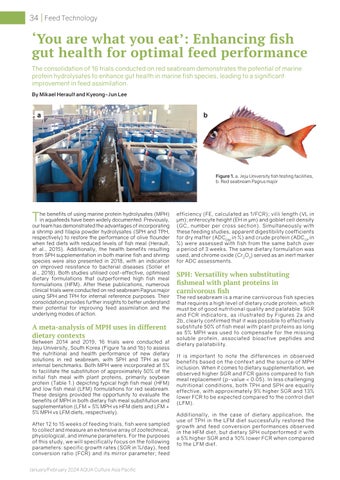34 Feed Technology
‘You are what you eat’: Enhancing fish gut health for optimal feed performance The consolidation of 16 trials conducted on red seabream demonstrates the potential of marine protein hydrolysates to enhance gut health in marine fish species, leading to a significant improvement in feed assimilation. By Mikael Herault and Kyeong-Jun Lee
a
b
Figure 1. a. Jeju University fish testing facilities, b. Red seabream Pagrus major
T
he benefits of using marine protein hydrolysates (MPH) in aquafeeds have been widely documented. Previously, our team has demonstrated the advantages of incorporating a shrimp and tilapia powder hydrolysates (SPH and TPH, respectively) to restore the performance of olive flounder when fed diets with reduced levels of fish meal (Herault, et al., 2015). Additionally, the health benefits resulting from SPH supplementation in both marine fish and shrimp species were also presented in 2018, with an indication on improved resistance to bacterial diseases (Soller et al., 2018). Both studies utilised cost-effective, optimised dietary formulations that outperformed high fish meal formulations (HFM). After these publications, numerous clinical trials were conducted on red seabream Pagrus major using SPH and TPH for internal reference purposes. Their consolidation provides further insights to better understand their potential for improving feed assimilation and the underlying modes of action.
A meta-analysis of MPH uses in different dietary contexts
Between 2014 and 2019, 16 trials were conducted at Jeju University, South Korea (Figure 1a and 1b) to assess the nutritional and health performance of new dietary solutions in red seabream, with SPH and TPH as our internal benchmarks. Both MPH were incorporated at 5% to facilitate the substitution of approximately 50% of the initial fish meal with plant proteins, primarily soybean protein (Table 1.) depicting typical high fish meal (HFM) and low fish meal (LFM) formulations for red seabream. These designs provided the opportunity to evaluate the benefits of MPH in both dietary fish meal substitution and supplementation (LFM + 5% MPH vs HFM diets and LFM + 5% MPH vs LFM diets, respectively). After 12 to 15 weeks of feeding trials, fish were sampled to collect and measure an extensive array of zootechnical, physiological, and immune parameters. For the purposes of this study, we will specifically focus on the following parameters: specific growth rates (SGR in %/day), feed conversion ratio (FCR) and its mirror parameter; feed January/February 2024 AQUA Culture Asia Pacific
efficiency (FE, calculated as 1/FCR); villi length (VL in µm); enterocyte height (EH in µm) and goblet cell density (GC, number per cross section). Simultaneously with these feeding studies, apparent digestibility coefficients for dry matter (ADC DM in %) and crude protein (ADC CP in %) were assessed with fish from the same batch over a period of 3 weeks. The same dietary formulation was used, and chrome oxide (Cr2O3) served as an inert marker for ADC assessments.
SPH: Versatility when substituting fishmeal with plant proteins in carnivorous fish
The red seabream is a marine carnivorous fish species that requires a high level of dietary crude protein, which must be of good nutritional quality and palatable. SGR and FCR indicators, as illustrated by Figures 2a and 2b, clearly confirmed that it was possible to effectively substitute 50% of fish meal with plant proteins as long as 5% MPH was used to compensate for the missing soluble protein, associated bioactive peptides and dietary palatability. It is important to note the differences in observed benefits based on the context and the source of MPH inclusion. When it comes to dietary supplementation, we observed higher SGR and FCR gains compared to fish meal replacement (p-value < 0.05). In less challenging nutritional conditions, both TPH and SPH are equally effective, with approximately 9% higher SGR and 13% lower FCR to be expected compared to the control diet (LFM). Additionally, in the case of dietary application, the use of TPH in the LFM diet successfully restored the growth and feed conversion performances observed in the HFM diet, but dietary SPH outperformed it with a 5% higher SGR and a 10% lower FCR when compared to the LFM diet.
